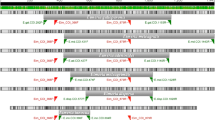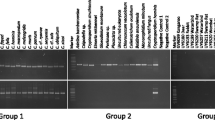Abstract
Molecular identification of Eimeria parasites infecting poultry and livestock has been commonly used for more than 20 years. An important step of the molecular identification technique is the rupturing of the oocyst wall for DNA extraction. Previously, DNA extraction methods included pre-treatment with sodium hypochlorite and osmotic shock with saturated salt solution. Here, we present a modification of this technique for a more sensitive and efficient identification of Eimeria spp. in field samples. The disruption extent of the oocyst walls, yield of DNA extraction, and identification of species-specific DNA sequences by PCR were used to evaluate this optimized method. Incubation of oocysts in sodium hypochlorite for 1.5 h at 4 °C followed by treatment with a saturated salt solution for 1 h at 55 °C broke up the walls of most Eimeria tenella oocysts, as well as other coccidian species of chicken and rabbit, such as Eimeria intestinalis and even Cryptosporidium cuniculus. Notably, polymerase chain reaction (PCR) amplification of the intervening transcribed sequence 1 (ITS-1) was successfully performed with genomic DNA extracted from just 50 oocysts using this optimized method. Our findings will greatly promote the development of molecular diagnosis methods of coccidiosis and simplify coccidian species identification and categorization as well as infection prevalence, providing a significant advancement in the development of techniques for coccidiosis control and prevention.






Similar content being viewed by others
References
Dulski P, Turner M (1988) The purification of sporocysts and sporozoites from Eimeria tenella oocysts using Percoll density gradients. Avian Dis 32(2):235–239. https://doi.org/10.2307/1590810
Duszynski DW, Speer CA, Chobotar B, Marchiondo AA (1981) Fine-structure of the oocyst wall and excystation of Eimeria procyonis from the American raccoon (Procyon lotor). Zeitschrift fur Parasitenkunde- Parasitol Res 65:131–136
Fernandez S, Pagotto AH, Furtado MM, Katsuyama AM, Madeira AM, Gruber A (2003) A multiplex PCR assay for the simultaneous detection and discrimination of the seven Eimeria species that infect domestic fowl. Parasitology 127(Pt 4):317–325. https://doi.org/10.1017/S0031182003003883
Hammond DM, Long PL (1973) The Coccidia. University Park Press, Baltimore, MD, USA, pp 151–154
Haug A, Thebo P, Mattsson JG (2007) A simplified protocol for molecular identification of Eimeria species in field samples. Vet Parasitol 146(1–2):35–45. https://doi.org/10.1016/j.vetpar.2006.12.015
Jackson A (1964) Isolation of viable coccidial sporozoites. Parasitology 54(01):87. https://doi.org/10.1017/S0031182000074369
Jenkins MC, Miska K, Klopp S (2006) Improved polymerase chain reaction technique for determining the species composition of Eimeria in poultry litter. Avian Dis 50(4):632–635. https://doi.org/10.1637/7615-042106R.1
Jinneman KC, Wetherington JH, Hill WE, Adams AM, Johnson JM, Tenge BJ, Dang NL, Manger RL, Wekell MM (1998) Template preparation for PCR and RFLP of amplification products for the detection and identification of Cyclospora sp. and Eimeria spp. oocysts directly from raspberries. J Food Prot 61(11):1497–1503. https://doi.org/10.4315/0362-028X-61.11.1497
Joyner LP, Long PL (1974) The specific characters of the Eimeria, with special reference to the coccidia of the fowl. Avian Pathol: J W.V.P.A 3(3):145–157
Kaya G, Dale C, Maudlin I, Morgan K (2007) A novel procedure for total nucleic acid extraction from small numbers of Eimeria species oocysts. Turkiye Parazitoloji Dergisi 31(3):180–183
Kumar S, Garg R, Moftah A, Clark EL, Macdonald SE, Chaudhry AS, Sparagano O, Banerjee PS, Kundu K, Tomley FM, Blake DP (2014) An optimised protocol for molecular identification of Eimeria from chickens. Vet Parasitol 199(1-2):24–31. https://doi.org/10.1016/j.vetpar.2013.09.026
Lee BH, Kim WH, Jeong J, Yoo J, Kwon Y, Jung BY, Kwon JH, Lillehoj HS, Min W (2010) Prevalence and cross-immunity of Eimeria species on Korean chicken farms. J Vet Med Sci 72(8):985–989. https://doi.org/10.1292/jvms.09-0517
Lew AE, Anderson GR, Minchin CM, Jeston PJ, Jorgensen WK (2003) Inter- and intra-strain variation and PCR detection of the internal transcribed spacer 1 (ITS-1) sequences of Australian isolates of Eimeria species from chickens. Vet Parasitol 112(PII S0304–4017(02)00393-X1–2):33–50
Long PL (1982) The Biology of the Coccidia. University Park Press, Baltimore, USA, pp 144–152
Long PL, Joyner LP (1984) Problems in the identification of species of Eimeria. J Protozool 31(4):535–541. https://doi.org/10.1111/j.1550-7408.1984.tb05498.x
Long PL, Millard BJ, Joyner LP, Norton CC (1976) A guide to laboratory techniques used in the study and diagnosis of avian coccidiosis. Folia Vet Lat 6(3):201–217
MacPherson JM, Gajadhar AA (1993) Differentiation of seven Eimeria species by random amplified polymorphic DNA. Vet Parasitol 45(3–4):257–266. https://doi.org/10.1016/0304-4017(93)90080-7
McDougald LR, Fuller L, Mattiello R (1997) A survey of Coccidia on 43 poultry farms in Argentina. Avian Dis 41(4):923–929. https://doi.org/10.2307/1592347
Morris GM, Woods WG, Richards DG, Gasser RB (2007) The application of a polymerase chain reaction (PCR)-based capillary electrophoretic technique provides detailed insights into Eimeria populations in intensive poultry establishments. Mol Cell Probes 21(4):288–294. https://doi.org/10.1016/j.mcp.2007.03.001
Nagi MS, Mathey WJ (1972) Interaction of Escherichia coli and Eimeria brunetti in chickens. Avian Dis 16(4):864–873. https://doi.org/10.2307/1588768
Raj GD, Aarthi S, Selvabharathi R, Raman M, Blake DP, Tomley FM (2013) Real-time PCR-based quantification of Eimeria genomes: a method to outweigh underestimation of genome numbers due to PCR inhibition. Avian Pathol 42(4):304–308. https://doi.org/10.1080/03079457.2013.790531
Ross R, Kleinz R, Reskekunz AB (1995) A method for rapid generation of competitive standard molecules for RT-PCR avoiding the problem of competitor probe cross-reactions. PCR-Methods Appl 4(6):371–375. https://doi.org/10.1101/gr.4.6.371
Schnitzler BE, Thebo PL, Mattsson JG, Tomley FM, Shirley MW (1998) Development of a diagnostic PCR assay for the detection and discrimination of four pathogenic Eimeria species of the chicken. Avian Pathol 27(5):490–49+
Scholtyseck E, Mehlhorn H, Hammond DM (1971) Fine structure of macrogametes and oocysts of Coccidia and related organisms. Z Parasitenkd 37(1):1–43. https://doi.org/10.1007/BF00259543
Shirley MW (1975) Enzyme variation in Eimeria species of the chicken. Parasitology 71(3):369–376. https://doi.org/10.1017/S0031182000047144
Shirley MW et al (2004) The Eimeria genome projects: a sequence of events. Trends Parasitol 20(5):199–201. https://doi.org/10.1016/j.pt.2004.02.005
Stucki U, Braun R, Roditi I (1993) Eimeria tenella: characterization of a 5S ribosomal RNA repeat unit and its use as a species-specific probe. Exp Parasitol 76(1):68–75. https://doi.org/10.1006/expr.1993.1008
Sun XM, Pang W, Jia T, Yan WC, He G, Hao LL, Bentue M, Suo X (2009) Prevalence of Eimeria species in broilers with subclinical signs from fifty farms. Avian Dis 53(2):301–305. https://doi.org/10.1637/8379-061708-Resnote.1
Taylor SM, Ohagan J, Mccracken A, Mcferran JB, Purcell DA (1973) Diarrhea in intensively reared lambs. Vet Rec 93(17):461–464. https://doi.org/10.1136/vr.93.17.461
Wang YZ, Tao GR, Cui YJ, Lv QY, Xie L, Li Y, Suo X, Qin YH, Xiao LH, Liu XY (2014) Molecular analysis of single oocyst of Eimeria by whole genome amplification (WGA) based nested PCR. Exp Parasitol 144:96–99. https://doi.org/10.1016/j.exppara.2014.06.019
Williams RB (1999) A compartmentalised model for the estimation of the cost of coccidiosis to the world’s chicken production industry. Int J Parasitol 29(8):1209–1229. https://doi.org/10.1016/S0020-7519(99)00086-7
Wilson PA, Fairbairn D (1961) Biochemistry of sporulation in oocysts of E. acervulina. J Protozool 8(4):410–416. https://doi.org/10.1111/j.1550-7408.1961.tb01236.x
Zhao XM, Duszynski DW, Loker ES (2001) A simple method of DNA extraction for Eimeria species. J Microbiol Methods 44(2):131–137. https://doi.org/10.1016/S0167-7012(00)00249-9
Acknowledgments
We thank Dr. Antonio Peramo for comments and revisions that greatly improved this manuscript.
Funding
This study was supported by the National Natural Science Foundation of China (Nos. 31330076 and 31572507), the earmarked fund for China Agriculture Research System (CARS-44), the Bill & Melinda Gates Foundation (OPP1160809), and the National Transgenic Major Program (No. 2014ZX0800603B).
Author information
Authors and Affiliations
Corresponding author
Ethics declarations
Conflict of interest
The authors declare that they have no conflict of interest.
Electronic supplementary material
ESM 1
(DOCX 8979 kb)
Rights and permissions
About this article
Cite this article
Tang, X., Huang, G., Liu, X. et al. An optimized DNA extraction method for molecular identification of coccidian species. Parasitol Res 117, 655–664 (2018). https://doi.org/10.1007/s00436-017-5683-8
Received:
Accepted:
Published:
Issue Date:
DOI: https://doi.org/10.1007/s00436-017-5683-8




